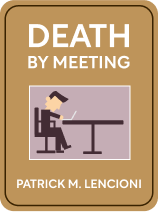

This article is an excerpt from the Shortform book guide to "Death By Meeting" by Patrick M. Lencioni. Shortform has the world's best summaries and analyses of books you should be reading.
Like this article? Sign up for a free trial here .
Do you find that your employees are bored during team meetings? How can you keep employees engaged and participating during meetings?
According to Patrick Lencioni’s book Death by Meeting, one of the best ways to keep your employees engaged in meetings is to add drama. Just like a good movie, meetings should have a hook to draw employees in, a conflict between characters (different employee opinions), and a resolution.
Keep reading to learn how you can keep your employees engaged during meetings.
How To Keep Employees Engaged in Meetings
In Death by Meeting, CEO Casey had never seriously considered working anywhere other than at Yip. He loved it there and he had no idea what he would do if J.T. pushed him out. His assistant ,Will, wanted to help as best as he could, and as he watched some movies to attempt to unwind, he realized that the problem with the meetings wasn’t the length but the lack of drama.
Will developed this theory and decided to present it to the team at the next meeting. Screenwriters had figured out that for a movie to be successful, it needs conflict, or a problem that needs to be solved or resolved. Will applied a similar logic to meetings. In fact, the decisions made in meetings are actually much more important to the participants’ lives than a movie.
Just like in the movies, meetings have to have a hook—a good beginning that leaves participants willing to digest necessary plot exposition that might be a little slower. Consider discussing a budget: It sounds boring. But if the leader of the discussion sets it up correctly—by explaining the stakes in the line items and the competitors breathing down the company’s neck—people will be more willing to engage.
Engage Conversations Around Differences of Opinion
After the setup of the conflict, keep looking for differences of opinion. It’s unlikely that, after the team airs their conflict, they will reach a complete consensus. However, everyone will feel better after airing their grievances and making compelling points on the behalf of their idea, and when a decision is made by a majority or by a leader, people will be more willing to support it, even if it wasn’t their original idea.
Casey and the team then practiced creating drama in meetings with a discussion about a picnic that the company was paying for by taking money out of the budgets of other departments. Though it seemed trivial, the picnic was a longstanding issue for the company. Many executives were angry that the company was taking out even a small amount of money from their budgets to fund the picnic, and the woman in charge of the picnic was frustrated because she didn’t even want to lead the event. When everyone involved aired their grievances, they all felt better. But still, Casey wasn’t perfect at facilitating discussion right away—he sometimes shied away from conflict or didn’t know when to move on from a topic—and Will thought that they could do better.
Will went back to thinking about the movies. He started developing theories, and with only two weeks to go now before the meeting with Wade, Will was nervous. He decided he needed to present his new theories to the team. According to Will, just like the movies and television, all good meetings have two big elements: drama and structure.
Have More Frequent Meetings
He also believed that even though this team had trouble with the meetings, they needed to have more of them.
- People often watch nightly news recaps that are five minutes—people are also willing to attend a five-minute daily meeting.
- A lot of people have a favorite drama on TV that airs about once a week and is an hour long. The weekly meetings can be an hour as well.
- About once a month, many Americans go to the movies and enjoy a two-hour event. The two-hour meetings should also be once a month.
- Finally, people will sometimes watch mini-series that are six hours long or more.

———End of Preview———
Like what you just read? Read the rest of the world's best book summary and analysis of Patrick M. Lencioni's "Death By Meeting" at Shortform .
Here's what you'll find in our full Death By Meeting summary :
- Why are meetings so important and detrimental at the same time
- The top 3 issues that commonly plague meetings
- Why a meeting where participants disagree can be a good thing






